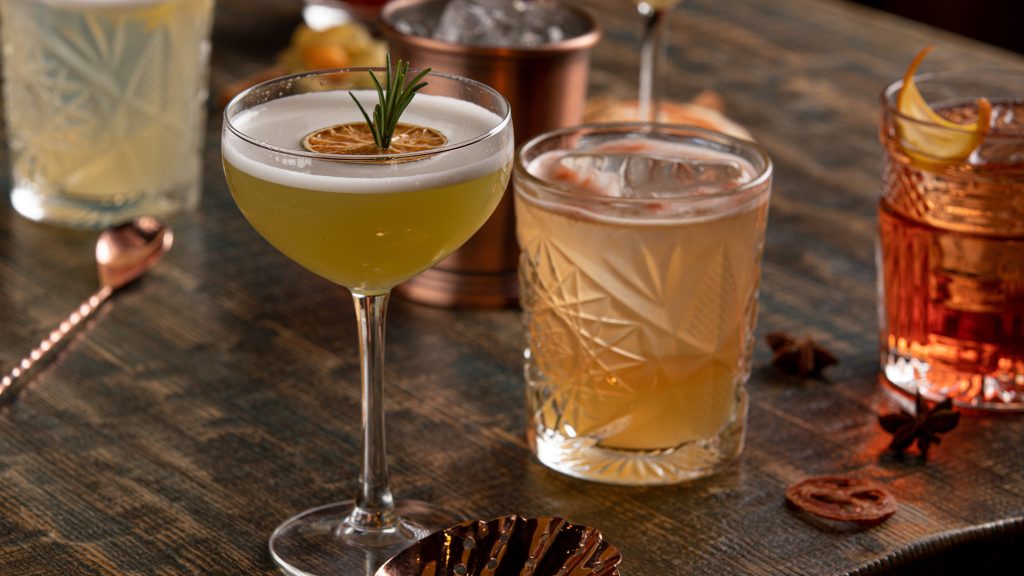If you’re a novice mixologist, making a great cocktail at home may seem daunting, especially with the sheer number of options in existence. Luckily, many classic builds are modeled after one another — whether on purpose or coincidentally — so once you’ve nailed the proportions of one, it’s easy to tinker with other elements to create several libations at the drop of a hat.
Many classics follow the Golden Ratio, which calls for two ounces of spirit, one ounce of sweetener, and one ounce of something sour for balance. Beyond the formula used, many of these drinks share most of the same ingredients. Take the Bee’s Knees and the Gold Rush as an example, which both include equal parts lemon juice and honey syrup and only diverge when it comes to spirit.
Here, we dig into some easy-to-make builds that share the same fundamental DNA. From Negronis and Boulevardiers to Sidecars and Margaritas, check out these same-but-different cocktails below.
The Gimlet and the Daiquiri
Both tangy and slightly sweet, the Gimlet and the Daiquiri are beloved classics dating back to the 19th century. While early versions of the former were taken down in the mid-1800s by members of the British Royal Navy to treat scurvy, the first official Gimlet recipe was published in 1923 in Harry McElhone’s “Harry’s ABC of Mixing Cocktails.” An ocean away, the Daiquiri was taking shape, though its origins are murky. The cocktail is generally believed to have been created in 1898 by Jennings Cox, an American engineer living in Cuba who supposedly named the cocktail after the town of Daiquiri. No matter their origins, only their spirits separate them: Add ¾ ounces of both lime juice and simple syrup to two ounces of gin and you have a Gimlet. Swap gin for rum, and you’ve made yourself a Daiquiri.
The Negroni and the Boulevardier
The Negroni’s popularity may suggest that the Boulevardier was created as a riff to capitalize on the bourbon boom, but in reality, the cocktails are almost the same age. Supposedly created in 1919 by a bartender in Florence, Italy looking to bolster an Americano, the Negroni fuses equal parts London dry gin, sweet vermouth, and Campari. The drink is boozy, herbal, and bitter, so if you want a cocktail on the sweeter side, simply opt for an ounce and a half of bourbon in place of gin and enjoy a Boulevardier. Created in 1920s Paris by American Erskine Geynne, the cocktail and its American whiskey bring vanilla-adjacent warmth to Campari’s more biting flavors.
The Manhattan and the Rob Roy
While the Manhattan and the Old Fashioned are often confused for one another, there’s actually a cocktail much more similar to the borough-named build: the Rob Roy. Created sometime in the mid-1800s, the Manhattan consists of two ounces of rye whiskey, one ounce of sweet vermouth, and two dashes of Angostura bitters. Roughly 10 years later at the Waldorf Hotel, the Rob Roy came along with blended Scotch in place of rye.
The Bee’s Knees and the Gold Rush
The Gold Rush was created at the now-shuttered Milk & Honey for a longtime regular as a riff on the Whiskey Sour, made sans egg white with honey syrup swapped for plain simple. In its final form, the cocktail — which features bourbon and lemon juice alongside the sweetener — bears a striking resemblance to the Bee’s Knees. The gin-based cocktail dates back to the Jazz Age and employs identical ingredients and proportions, save for the base spirit.
The Southside and the Mojito
The Southside and the Mojito share the same concept — a bright herbal medley of mint and lime — though their executions drastically differ. The former, which is made with gin, simple syrup, fresh lime juice, and mint leaves, sees all ingredients shaken up before they’re strained and poured into a chilled coupe. But double the mint and muddle it in a highball glass before adding simple syrup, fresh lime juice, and rum in place of gin, and you’ll have yourself a Mojito.
The Sidecar and the Margarita
When it comes to cocktail composition, it doesn’t get much more classic than the spirit-sweet-sour formula — and both the Sidecar and the Margarita follow this blueprint to a tee. While the cocktails may have originated on different continents, both feature two ounces of booze, one ounce of citrus juice, and ¾ ounces of triple sec. Opt for brandy, lemon juice, and a chilled coupe sans ice and it’s a Sidecar. In the mood for tequila instead? Shake it up with a bit of lime juice before straining over ice in a lowball glass to enjoy a Margarita.
The Last Word, the Naked and Famous, and the Paper Plane
The Naked and Famous and the Paper Plane are two modern riffs of the Last Word, and each spice up the four-part build in their own way. The yellow-hued Last Word fuses gin, green Chartreuse, and Maraschino liqueur for a bittersweet and herbal base brightened by zippy lime juice. Swap gin for mezcal, green Chartreuse for its sister yellow Chartreuse, and Aperol for Maraschino liqueur and you’ve built the base for the smoky, lime-spiked Naked and Famous. The Paper Plane offers a darker spin with its bourbon, Amaro Nonino, Aperol, and lemon juice.
*Image retrieved from Volodymyr Shcerbak via stock.adobe.com
The article Swap This, Get That: Classic Cocktails That Are Almost the Same Drink appeared first on VinePair.
